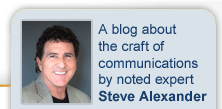More lessons from a 10-year old: The case of the missing ‘dial-tone’
In the communications world, we’re constantly looking for those anecdotes and stories that help others learn about the importance and challenges of communicating to our audiences. One recently occurred with a little friend of mine (‘little’ meaning 10 years old!) in trying to help her solve a problem. It helped underscore the importance of using language that has meaning to the receiver, and of making sure our communications are audience-focused.
She called me, as a family friend, from her mom’s mobile phone to tell me they were having trouble with their new television and video-streaming reception (not that I’m an expert by any stretch, however, I’m a practiced tinkerer and have some talent in unexpected areas beyond my day job!). It seemed like nothing was working. Because they had one of those full-service, one-provider arrangements, I asked if the house phone worked. She didn’t know (and rarely uses it), so I asked her to pick up the phone and listen for the dial-tone. Her response was startling!
“What’s a dial-tone?”
At first I thought she was teasing me (something she learned from me and at which she is now well-practiced). I repeated my question, and asked if she could hear the dial-tone on the house phone. For context, this is someone with an iPad, iPod and notebook computer, and who uses her mom’s mobile phone for voice communication. Once she knows your eddress, you’re a regular in her ‘Contacts’ list, and are sure to be updated on her life activities via email, texts, etc.
I was a bit taken aback and started to describe what a dial-tone was when I realized she was of a generation that had no real experience with the concept, and that I’d lost my ‘audience’ because I was unable to speak in a language and with words, symbols and substance that she understood. In my inability to explain and attempt to grasp for comparisons, this thought came to me: How often do we communicate in a language, at a time, with an emotion or intent that makes complete sense to us, but leaves our audiences, our listeners, totally disconnected (pardon the pun!)?
We act based on what WE think WE know, rather than taking the time to understand what our audiences/listeners know and need. It’s a focal point of a lot of the professional coaching I do as well. Often my counsel (when clients present a challenge in communicating with someone) is to slow down, think about the person they are communicating to, and ask them to apply the old ‘put yourself in their chair’ exercise. For example, what is that person thinking? What experiences do they bring to the conversation? What are their needs, wants, desires; fears, apprehensions, anxieties? Apply the “Seek first to understand, rather than to be understood” lesson. In other words, focus on your audience.
When we train speakers, it’s the same advice. Ask, why are folks sitting in their chairs listening to me? Why are they there? What do they want? (Rather than the classic speaker’s mistake of asking: What do I want to tell them?)
This little 10-year old is pretty sharp, and eventually I was able to help her with her problem. It made me aware that a mobile-phone generation may NEVER hear a dial-tone, and that word, like so many others, illustrates the need for changing language, symbols and substance as we communicate to others who may have a different perspective, background, culture, history, etc. than we do. We need to understand what others need and want from the communication, presentation, meeting, or other interaction they’re having with us, and help understand their ‘language,’ and where they are coming from in the midst of their challenge, or solution-seeking.
And remember, we may be speaking ‘dial-tone,’ and they may be speaking ‘mobile phone,’ and we both may lose out on making an important connection!




